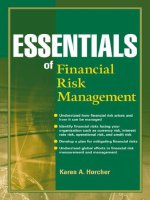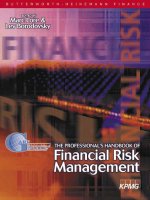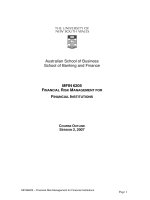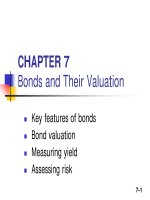Elements of financial risk management chapter 7
Bạn đang xem bản rút gọn của tài liệu. Xem và tải ngay bản đầy đủ của tài liệu tại đây (866.06 KB, 55 trang )
1
Covariance and Correlation Models
Elements of
Financial Risk Management
Chapter 7
Peter Christoffersen
Elements of Financial Risk Management Second Edition © 2012 by Peter Christoffersen
Overview
2
• This Chapter models dynamic covariance and correlation,
which along with dynamic volatility models is used to
construct covariance matrices.
• Chapter 8 will describe simulation tools such as Monte
Carlo and bootstrapping, which are needed for multiperiod
risk assessments.
• Chapter 9 will introduce copula models used to link
together the nonnormal univariate distributions.
• Correlation models only allow for linear dependence
between asset returns whereas copula models allow for
nonlinear dependence.
Elements of Financial Risk Management Second Edition © 2012 by Peter Christoffersen
Portfolio Variance and Covariance
• Consider a portfolio of n securities
• The return on the portfolio on date t+1 is
• The sum is taken over the n securities in portfolio
• wi,t denotes the relative weight of security i at the end of
day t.
Elements of Financial Risk Management Second Edition © 2012 by Peter Christoffersen
3
Portfolio Variance and Covariance
• The variance of the portfolio is
• Where ij,t+1 and ij,t+1 are covariance and correlation
respectively between security i and j on day t+1
• Note ij,t+1 = ji,t+1 and ij,t+1 = ji,t+1 for all i and j
• Also we have ii,t+1 =1 and ii,t+1 =2i,t+1 for all i
Elements of Financial Risk Management Second Edition © 2012 by Peter Christoffersen
4
Portfolio Variance and Covariance
• Using vector notation we can write:
• where wt is the n by 1 vector of portfolio weights and
t+1 is the n by n covariance matrix of returns
• In the case where n = 2 we have
Elements of Financial Risk Management Second Edition © 2012 by Peter Christoffersen
5
Portfolio Variance and Covariance
6
• If we assume assets are multivariate normally distributed,
then the portfolio is normally distributed and we can write,
• Note: if we have n assets in the portfolio then we have to
model n(n-1)/2 different correlations
• So if n is 100, then we’ll have 4950 correlations to model, a
daunting task that forces us to find methods that can easily
handle large-dimensional portfolios
Elements of Financial Risk Management Second Edition © 2012 by Peter Christoffersen
Exposure Mapping
• One way to reduce dimensionality of portfolio variance is
to impose a factor structure using observed market returns
as factors.
• In the extreme case we assume that portfolio return is the
market return plus a portfolio specific risk term:
• where we assume that the idiosyncratic risk term, t+1, is
independent of the market return and has constant
variance.
• The portfolio variance in this case is
Elements of Financial Risk Management Second Edition © 2012 by Peter Christoffersen
7
Exposure Mapping
8
• In a well diversified stock portfolio, for example, we can
assume that the variance of the portfolio equals that of the
S&P 500 market index.
• In this case, only one volatility needs to be modelled, and
no correlation modelling is necessary.
• This is referred to as index mapping and written as:
• The 1-day VaR assuming normality is
Elements of Financial Risk Management Second Edition © 2012 by Peter Christoffersen
Exposure Mapping
• In general, portfolios that contain systematic risk have
• So that
• If the portfolio is well diversified then the portfoliospecific risk can be ignored, and we can pose a linear
relationship between the portfolio and the market index
and use the beta mapping as
• Here only an estimate of is necessary and no further
correlation modelling is needed.
Elements of Financial Risk Management Second Edition © 2012 by Peter Christoffersen
9
Exposure Mapping
10
• The risk manager of a large-scale portfolio may consider
risk coming from a reasonable number of factors nF where
nF << n so that we have many fewer risk factors than assets
• Let us assume that we need 10 factors.
• We can write the 10-factor return model as
• here t+1 is assumed to be independent of risk factors
• In this case, it makes sense to model the variances and
correlations of these risk factors and assign exposures to
each factor to get the portfolio variance.
Elements of Financial Risk Management Second Edition © 2012 by Peter Christoffersen
Exposure Mapping
11
• The portfolio variance in this general factor structure can be written
• where βF is a vector of exposures to each risk factor and
where Ft+1 is the covariance matrix of the returns from
the risk factors.
• Again, if the factor model explains a large part of the
portfolio return variation, then we can assume that
Elements of Financial Risk Management Second Edition © 2012 by Peter Christoffersen
GARCH Conditional Covariance
• Suppose a portfolio contains n assets or factors. An ndimensional covariance matrix must be estimated where n
may be a large number.
• Now, we turn to various methods for constructing the
covariance matrix directly, without first modeling the
correlations.
The simplest way to model time varying covariances is to
rely on plain rolling averages.
• For the covariance between assets i and j, we can simply
estimate
Elements of Financial Risk Management Second Edition © 2012 by Peter Christoffersen
12
GARCH Conditional Covariance
13
• where m is the number of days used in the moving
estimation window
• This estimate is very easy to construct but it is not
satisfactory due to dependence on choice of m and equal
weighting put on past cross products of returns
• We assume that the average expected return on each asset is
zero
Elements of Financial Risk Management Second Edition © 2012 by Peter Christoffersen
Figure 7.1: Rolling Covariance between S&P 500
and 10-Year Treasury Note Index
Elements of Financial Risk Management Second Edition © 2012 by Peter Christoffersen
14
GARCH Conditional Covariance
15
• To avoid equal weighting we can use a simple exponential
smoother model on the covariances, and let
• where =0.94 as it was for the corresponding
volatility model in the previous chapters
Elements of Financial Risk Management Second Edition © 2012 by Peter Christoffersen
16
Figure 7.2: Exponentially Smoothed Covariance
between S&P 500 and 10-year Treasury Note Index
Elements of Financial Risk Management Second Edition © 2012 by Peter Christoffersen
GARCH Conditional Covariance
17
• The caveats which applied to the exponential smoother
volatility model, apply to the exponential smoother
covariance model as well
• The restriction that the coefficient (1-) on the cross
product of returns ( Ri ,t R j ,t )and coefficient on the past
covariance ( ij ,t ) sum to one is not desirable.
• The restriction implies that there is no mean-reversion in
covariance
• If tomorrow’s forecasted covariance is high then it will
remain high for all future horizons, rather than revert
back to its mean.
Elements of Financial Risk Management Second Edition © 2012 by Peter Christoffersen
GARCH Conditional Covariance
18
• We can instead consider models with mean-reversion in
covariance.
• For example, a GARCH-style specification for covariance
would be
• which will tend to revert to its long-run average covariance,
which equals
Elements of Financial Risk Management Second Edition © 2012 by Peter Christoffersen
GARCH Conditional Covariance
19
• Note that we have not allowed for the persistence
parameters , and to vary across pairs of securities in
the covariance models
• This is done to guarantee that the portfolio variance will be
positive regardless of the portfolio weights, wt.
• A covariance matrix t+1 is internally consistent if for all
possible vectors wt of portfolio weights we have
• Thus covariance matrix is positive semidefinite. It is
ensured by estimating volatilities and covariances in an
internally consistent fashion.
Elements of Financial Risk Management Second Edition © 2012 by Peter Christoffersen
GARCH Conditional Covariance
20
• For example, relying on exponential smoothing using the
same for every volatility and every covariance will work.
• Similarly, using a GARCH(1,1) model with and
identical across variances and covariances will work as
well.
• Unfortunately, it is not clear that the persistence parameters
and should be the same for all variances and
covariance
• We therefore next consider methods that are not subject to
this restriction
Elements of Financial Risk Management Second Edition © 2012 by Peter Christoffersen
Dynamic Conditional Correlation
21
• Now we will model correlation rather than covariance
• Variances and covariance are restricted by the same
persistence parameters
• Covariance is a confluence of correlation and variance.
Could be time varying just from variances.
• Correlations increase during financial turmoil and thereby
increase risk even further
• Therefore, modeling correlation dynamics is crucial to a risk
manager
• Correlation is defined from covariance and volatility by
Elements of Financial Risk Management Second Edition © 2012 by Peter Christoffersen
Dynamic Conditional Correlation
22
• If we have the RiskMetrics model, then
• and then we get the implied dynamic correlations
• which isn’t particularly intuitive, we therefore consider
models where dynamic correlation is modeled directly
• The definition of correlation can be rearranged to provide
the decomposition of covariance into volatility and
correlation
Elements of Financial Risk Management Second Edition © 2012 by Peter Christoffersen
Dynamic Conditional Correlation
23
• In matrix notation, we can write
• where Dt+1 is a matrix of standard deviations, i,t+1, on the
ith diagonal and zero everywhere else, and where t+1 is a
matrix of correlations, ij,t+1, with ones on the diagonal.
• In the two-asset case, we have
Elements of Financial Risk Management Second Edition © 2012 by Peter Christoffersen
Dynamic Conditional Correlation
24
• We will consider the volatilities of each asset to already
have been estimated through GARCH or one of the other
methods considered in Chapter 4 or 5
• We can then standardize each return by its dynamic
standard deviation to get the standardized returns,
• By dividing the returns by their conditional standard
deviation, we create variables, zi,t+1, i = 1,2,…,n, which all
have a conditional standard deviation of one
Elements of Financial Risk Management Second Edition © 2012 by Peter Christoffersen
Dynamic Conditional Correlation
25
• The conditional covariance of the zi,t+1 variables equals the
conditional correlation of the raw returns as can be seen
from
• Thus, modeling the conditional correlation of the raw
returns is equivalent to modeling the conditional
covariance of the standardized returns
Elements of Financial Risk Management Second Edition © 2012 by Peter Christoffersen









